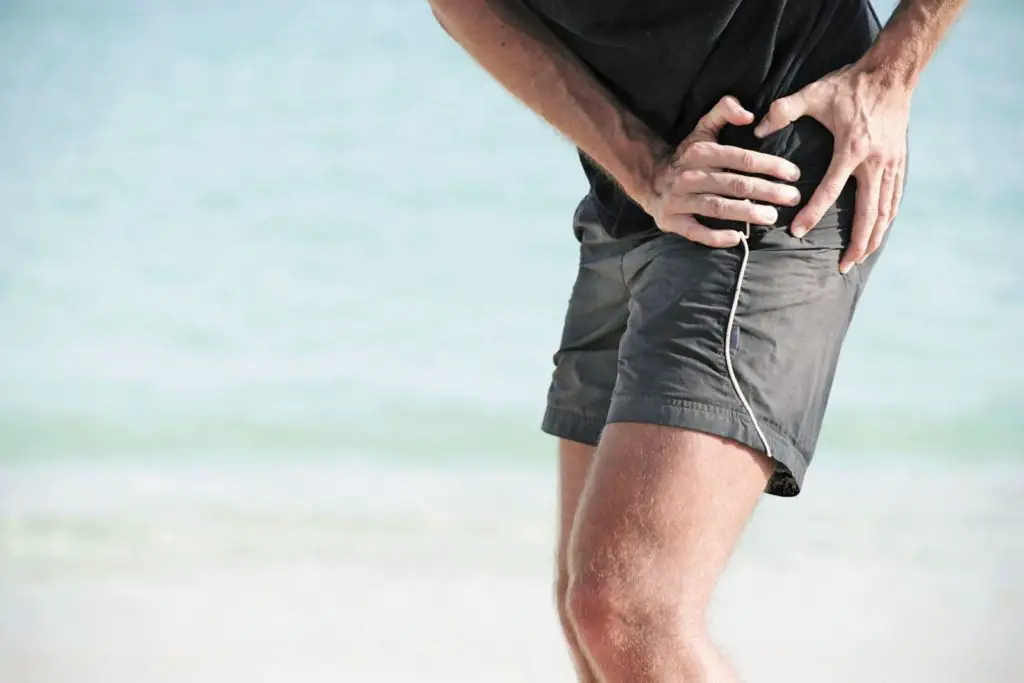Article reviewed and approved by Dr. Ibtissama Boukas, physician specializing in family medicine
Performance and increased survival of prostheses total hip have significantly reduced the recourse to arthrodesis on native hip. Which led us to ask a few questions: restrict these indications is it a good idea? Is there such a reliable intervention instead ? And finally, which are the cases where hip arthrodesis is always justified ? To answer these questions, let's find out together everything there is to know about this operation.
Definition
A arthrodesis is a Surgical Interventionand intended for block an injured joint in order to obtain a bone fusion, in order to correct a deformation. It's an operation often not reversible. His benefits are the stability and indolence (pain relief).
THEhip arthrodesis consists of get a bone fusion between femur and part of the pelvis. The pelvis, which is made up of 3 bony parts: the iliac, the ischium (or the sacrum) and the coccyx (pubis). The whole is held together by powerful muscles and ligaments behind and in front.
The pelvis has several joints dedicated to mobility and standing: namely the hip joint, also called the coxo-femoral joint, the sacroiliac joint and the pubic symphysis.
It exists two types byhip arthrodesis : I'coxofemoral arthrodesis, that is, the fusion between the upper part of the femur and the coccyx and theischiofemoral or iliofemoral arthrodesis (extra-articular arthrodesis).
What is the difference with the hip prosthesis?
The difference between the two techniques (arthrodesis and hip prosthesis) is that the hip prosthesis is a hip joint replacement by total prosthesis. This solution is more suitable when the wear of the cartilage is significant (in the case of osteoarthritis for example) and when there is significant pain and a serious loss of mobility. She should be offered as a last resort after trying several other approaches.
To know everything about the hip prosthesis, see the following article.
Hip arthrodesis is used much less nowadays
The advent and current progress of hip replacements have made the indications for arthrodesis almost obsolete, even if this therapeutic possibility should always be considered in very young subjects. This is related to the long-term risk of hip replacements.
What are the valid indications for this arthroplasty technique?
The indications for hip arthrodesis have evolved a lot over the last 30 years. Their rarefaction is essentially linked to the development of total arthroplasties.
However, these therapeutic possibilities must always be considered in young subjects because of the uncertain future of hip prostheses in the very long term.
The main indications of this technique are:
- The post-traumatic ultimate failures ;
- The failure of hip arthroplasty without the possibility of recourse to a prosthetic revision, either for mechanical reasons (major joint destruction, deficit of bone stock, neurological or muscular disorders), or for infectious or medical reasons (for example, significant anesthetic risk).
In these two indications, the realization of a hip arthrodesis remains delicate and can direct towards the choice of a resection of the hip.
Finally, this surgery keeps a topical field for categories of patients in whom arthroplasty has a relative contraindication or a risk-benefit ratio unfavorable to arthroplasty :
- these are the neuro-orthopedic patients ;
- opportunities, patients at high septic risk (such as tuberculous affections of the hip);
- opportunities, osteoporotic patients… It gives a “stable” and “painless” hip.
To date, thetotal hip arthroplasty provides excellent results, but the medium and long-term risk is all the more important when the patient is young. This exposes the latter to more complex surgical revisions and more uncertain results. Hip arthrodesis should therefore be discussed in young, active patients with unilateral hip involvement.
How are the procedures carried out ?
Hip arthrodesis is the surgical fusion opportunities, hip joint surfaces, between the basin and proximal femur. The process may include thepin insertion, plates and surgical screws. The goal of arthrodesis is to restore, strengthen and stabilize a failing hip joint.
We distinguish the intra-articular arthrodesis (coxofemoral) and the extra-articular arthrodesis (iliofemoral or ischiofemoral).
The fusion position of the coxofemoral joint determines the success and the quality of the position of the arthrodesis. It allows, among other things, static and dynamic adaptation at the level of the spine and the knee. The arthrodesis position must combine:
- a 20° flexion in the young subject to favor the standing position or a 30° flexion in the older subject to favor the seated position;
- slight adduction of 5° to 10° (i.e. bringing the lower limb closer to the longitudinal axis of the body);
- and slight external rotation.
Intra-articular arthrodesis (coxofemoral)
Many techniques have been described. They have in common thebrightening of articular surfaces (i.e. a technique which consists of placing articular surfaces side by side in order to favor their adjoining) associated with a rigid fixing. Fixation obtained by double or triple femoro-iliac screwing in the direction of the roof of the acetabulum using large diameter screws (6 or 7 mm).
Extra-articular arthrodesis
A distinction is made between iliofemoral arthrodesis and ischiofemoral arthrodesis.
The iliofemoral arthrodesis consist of fix a graft between theiliac wing and apex of the greater trochanter. This technique was abandoned, because their fusion is extremely long and there are many failures.
THEischiofemoral arthrodesis has the principle ofembed a large graft between posterior aspect of the greater trochanter and ischial tuberosity. It is then fixed by one or two screws. Additional support by iliofemoral fixator is necessary.
Are there any complications ?
The early complications of hip arthrodesis are as follows:
Thrombophlebitis
It's a hassle reaction. It is subject to systematic preventive treatment by low molecular weight heparin ou vitamin K antagonist, best associated with wearing compression stockings.
Infections
They are raresMore formidable.preventive antibiotic therapy after the operation is systematic.
Paresis or paralysis
Depending on the approach, certain nerves may be traumatized giving a sensorimotor deficit specific :
- the lesion of sciatic nerve gives a motor deficit of the foot elevators, and external stabilizers of the ankle;
- damage to the femoral nerve (crural nerve) comprises, essentially, painful phenomena of the anterior face of the thigh…
Late complications
The long-term results of arthrodesis showed that, for most patients, professional activity was possible with hip arthrodesis.
Some patients present with discomfort in daily life for the footwear, the prolonged sitting position or sports practice. However, the majority of patients have a walking distance greater than 2 kilometers and are able to continue their professional activity (especially manual and physical work).
In the long term, a overload of neighboring joints may occur (on average, 20 years after the intervention). the Lumbar spine and the underlying knee will deteriorate and become painful, giving a picture of low back pain and ipsilateral knee pain. This results from a significant alteration in the biomechanics of the adjacent joints.
What about rehabilitation after surgery ?
Rehabilitation is very specific and oriented towards revival of monoarticular muscles, which had been inactive for many years. This is a relearning movement. The possibilities of muscle recovery are partly linked to the technique of arthrodesis. He is oriented around opportunities, trophic disorders, range of motion and muscle quality and function.
In case of'surgical arthrodesis, hopes for complete muscle recovery are limited, and many patients require theuse mandatory a cane after surgery.
Rehabilitation after arthrodesis by freshening and screwing
La first phase of rehabilitation consists of get up early without support and knee rehabilitation. Support is gradually authorized from the third month. The fixator is removed, depending on the patient's tolerance level.
Sources
- https://www.mercy.com/health-care-services/orthopedics-sports-medicine-spine/specialties/hip/treatments/arthrodesis-or-fusion-surgery-for-the-hip?fbclid=IwAR1b43sloBQ-qNctOOVG2rAT4FYEJg_bto9S5FPgPPYyx8aqaG9hVABhPVA
- https://www.sciencedirect.com/science/article/abs/pii/S1769685205000043
- https://www.revmed.ch/view/548763/4406008/RMS_idPAS_D_ISBN_pu2010-46s_sa05_art05.pdf


